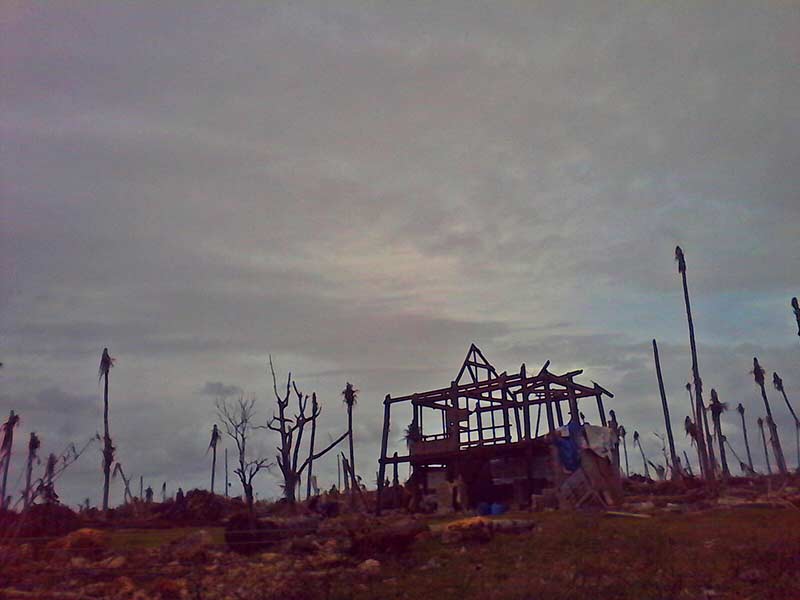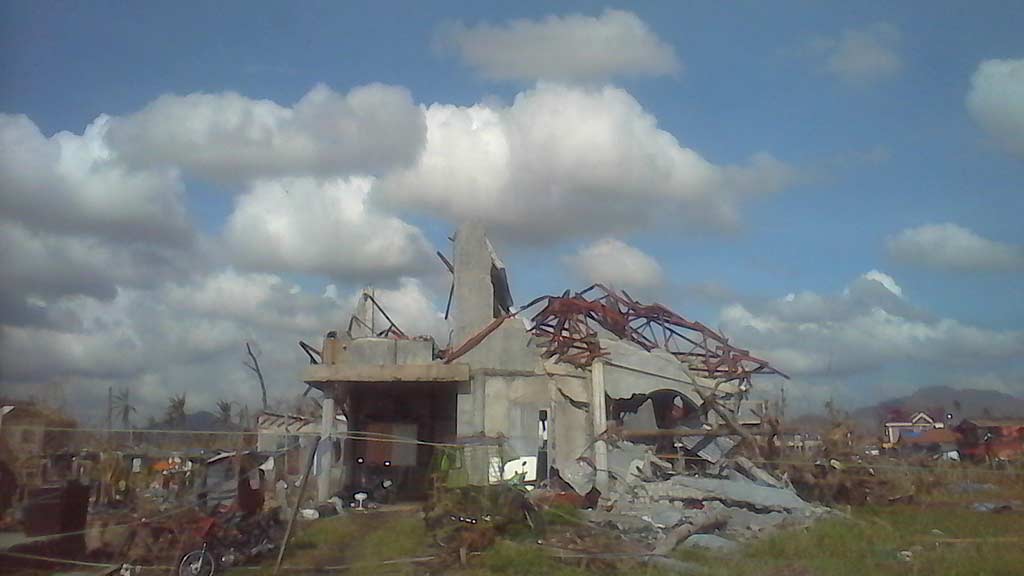by Edel S. Garingan
November 7, 2013. Few hours before the monster storm took a landfall in the Philippines, Marissa Cano, a local journalist in Baybay, Leyte was contemplating on the stillness of the night. She settled herself on her bed thinking that it was just an ordinary night, unaware that in next morning she and her family will be battling against the strongest typhoon to ever hit the country… while more than 6,000 people from the pathway of the storm will perish, thousands more will remain untraceable in the coming days, survivors will resort to looting in Tacloban for some days, the government will face a tough ordeal and the survivors will continue to suffer beyond the wind and the waves.
Unlike Marissa, about 233 kilometers away from Baybay, Susan Tan, owner of Tanghay View Lodge in Guiuan, Samar was having coffee with her guest, Vanessa, who came to the town for a potential business venture – together they were sensing the coming of a super typhoon that is according to the reports had been gaining wind power in the Pacific Ocean. But the night was calm and that brought chills to Susan and Vanessa. On her Facebook page Susan wrote, ‘No wind, no air. This is scary!’ And it was.
Around 11:00 pm, about three dogs were exchanging their grunts killing the quietness of the night. A few seconds after the barking stopped, the wind started to blow, this signaled Vanessa that she needs to go back to her room in the second floor and try to find escape. She tried to look into the window to check what was happening outside — she saw nothing but thick clouds. Every minute the wind was getting stronger and even crazier. “I no longer feel safe here”, Vanessa was texting and updating her husband in Minnesota, USA. Her last text to him was, “ I love you both” referring also to her child.
On the ground floor, Susan and her staff were busy securing every furniture and other things from being blown away in the air. They first closed the porch door towards the Leyte Gulf, and then the others. When they are about to close the one facing the main road, the wind was gusting forcefully that they could no longer make a step. The sliding door was flipping upside down that in any moment it could flutter inside the room damaging anything and anyone it touches on.
Despite the chaos, Susan was able to protect herself by covering her head with a pillow while her backpack served as a shield from any splinters that may hit her on the back. Susan saw that the sea was already running to her lawn and in no time might already encroach inside the lodge. They have to move to the second floor.
On the second floor, Vanessa saw how the wind ripped off some walls and threw them just in any direction. The bed in the other room was lifted in the air and fanned directly to the ocean. She tried to go to the ground floor and scream for help but the wind was shaking her gravely that she could barely walk. She decided to stay inside the built-in cabinet. For more than one hour, she was holding the knob praying that everything will end soon.

Susan had to cross from the dining area to the lobby and finally to the stairs going to the second floor. In an ordinary day, it will take her less than a minute to do it, but that time, it was a big ordeal. Still afraid of the door flipping in the other end of the room, Susan in all her might, used one of the dining tables as her shield. She was pushing it covering her body as she take every single step going to the lobby. Every strong blow she had to stop, her staff extended some sturdy rope for her to hold on and to gain stability; it took her more than an hour just to reach her way of escape to the second floor.
Some kilometers away from Tanghay Lodge is the house of Nonita Cabacaba, chief of the Bureau of Fisheries and Aquatic and Resources (BFAR) in Guiuan. On the night before the storm, Nonita was busy accommodating guests of the BFAR office; she had to ensure that they would have a good and safe place to stay for the night. Ten hours later, she was pressing her body against her room’s wooden door, holding unto the knob just to ensure that it will not wobble in the air – she was on this plight for more than one hour. Holding unto the knob praying that the typhoon calms down before it reach Tacloban city.
In Tacloban, 144 km from Guiuan, inside the BFAR Region VIII office in Brgy. Diit, Nonita’s husband and other rescuers were cautiously waiting for any operation that they will do once the typhoon set foot in the city. By six o’clock in the morning the wind blew more ferociously in every direction. Then the unthinkable happened. Typhoon Yolanda pushed ashore giant waves towering about 20 feet and destroying just anything on its foot. The wind and the killer waves that Yolanda brought to Tacloban spared almost no one, in just a manner of seconds, the rescuers, among others also need to be rescued.
For the first time, Marissa was astounded by a typhoon; she witnessed just how incredibly strong Yolanda was even though it did not fully touch down in Baybay. The wind damaged her house losing some portion of the roof, relatively a very low grunge compare to the destruction that the typhoon brought to many infrastructures in Guiuan, Tacloban, Ormoc and many other areas.
When the wind finally calmed down, Vanessa rushed to her grandmother and some relatives in Barangay Sulangan; she was relieved to know that they were all safe. She was able to contact her husband in the US through the ‘free call’ service initiated by Susan days after the havoc. Eventually, her husband went to Guiuan to assure her safety and also help in some rehabilitation efforts of the town. Nonita’s husband survived the storm and came home to Guiuan days after. They are now busy cleaning and reorganizing things in the BFAR’s office.
Seconds after the storm and looking at the obliterations that it caused, Susan asked herself, “Saan ako magsisimula?” A question that many other victims and survivors from the whole stretch of Visayas region and some islands in Luzon is also asking.
While people in the Visayas region continue to rebuild their lives and many Filipinos are still trying to understand what storm surge is and the scales of its impact, one big truth had confronted the country by surprise: stronger winds and bigger waves are coming to us and although the Filipino spirit is always high and present, it is time that we spend more efforts and time to prepare.
(This article was written in December 2013, few days after we visited the area roughly two weeks after Typhoon Yolanda.)

